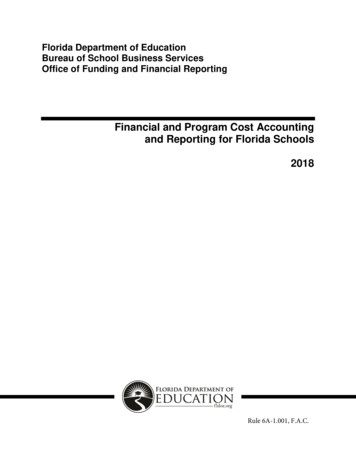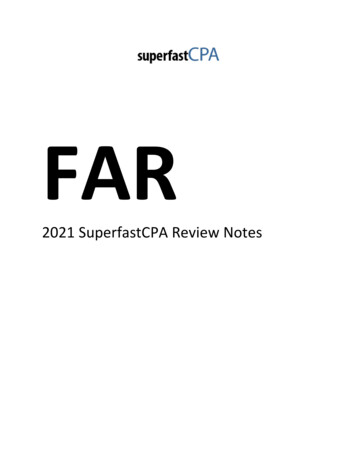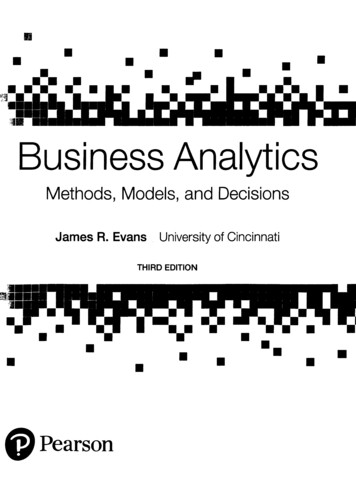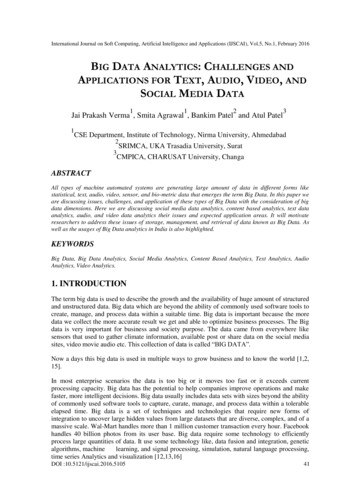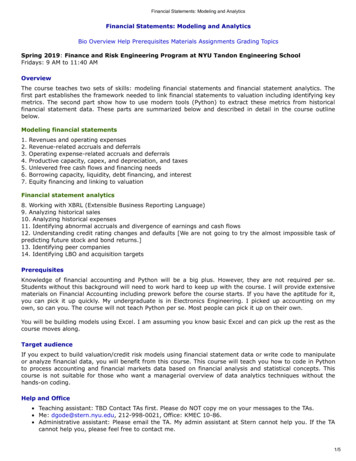
Transcription
Financial Statements: Modeling and AnalyticsFinancial Statements: Modeling and AnalyticsBio Overview Help Prerequisites Materials Assignments Grading TopicsSpring 2019: Finance and Risk Engineering Program at NYU Tandon Engineering SchoolFridays: 9 AM to 11:40 AMOverviewThe course teaches two sets of skills: modeling financial statements and financial statement analytics. Thefirst part establishes the framework needed to link financial statements to valuation including identifying keymetrics. The second part show how to use modern tools (Python) to extract these metrics from historicalfinancial statement data. These parts are summarized below and described in detail in the course outlinebelow.Modeling financial statements1.2.3.4.5.6.7.Revenues and operating expensesRevenue-related accruals and deferralsOperating expense-related accruals and deferralsProductive capacity, capex, and depreciation, and taxesUnlevered free cash flows and financing needsBorrowing capacity, liquidity, debt financing, and interestEquity financing and linking to valuationFinancial statement analytics8. Working with XBRL (Extensible Business Reporting Language)9. Analyzing historical sales10. Analyzing historical expenses11. Identifying abnormal accruals and divergence of earnings and cash flows12. Understanding credit rating changes and defaults [We are not going to try the almost impossible task ofpredicting future stock and bond returns.]13. Identifying peer companies14. Identifying LBO and acquisition targetsPrerequisitesKnowledge of financial accounting and Python will be a big plus. However, they are not required per se.Students without this background will need to work hard to keep up with the course. I will provide extensivematerials on Financial Accounting including prework before the course starts. If you have the aptitude for it,you can pick it up quickly. My undergraduate is in Electronics Engineering. I picked up accounting on myown, so can you. The course will not teach Python per se. Most people can pick it up on their own.You will be building models using Excel. I am assuming you know basic Excel and can pick up the rest as thecourse moves along.Target audienceIf you expect to build valuation/credit risk models using financial statement data or write code to manipulateor analyze financial data, you will benefit from this course. This course will teach you how to code in Pythonto process accounting and financial markets data based on financial analysis and statistical concepts. Thiscourse is not suitable for those who want a managerial overview of data analytics techniques without thehands-on coding.Help and OfficeTeaching assistant: TBD Contact TAs first. Please do NOT copy me on your messages to the TAs.Me: dgode@stern.nyu.edu, 212-998-0021, Office: KMEC 10-86.Administrative assistant: Please email the TA. My admin assistant at Stern cannot help you. If the TAcannot help you, please feel free to contact me.1/5
MaterialsI will not require a textbook. I will distribute handouts in class and have online assignments.AssignmentsOnline assignments.Exams and GradingAssignments: 40%Attendance: 10%Final exam: 50%TopicsTopic 1: Modeling sales and operating expenses other than depreciationSales and sales growthPotential market sizeMarket share and pricing powerOperating expensesCost structure and competitive advantageFixed costs versus variable costsGeneral model of accruals and deferralsA generalized model of the timing differences between income flows and cash flowsAccruals: When income flows precede cash flowsDeferrals: When income flows follow cash flowsUnderstanding lead/lag functions as an efficient and powerful way to model accruals/deferralsTopic 2: Modeling revenue-related accruals and deferralsReceivables: Accrued revenues or deferred receiptsWhen revenues precede receiptsCollection periodLong-term receivables and interest earnedAllowance for returns and bad debtsAccruing contra-revenues in anticipation of returnsAccruing bad debt expenses in anticipation of write-offsContra-assets: Allowance for returns and bad debtsAdvance received or deferred revenuesDeliverables: When revenues follow receiptsSubscription-based models: Receipts drive future revenuesEvent-based models: Future expected revenues drive current receiptsTopic 3: Modeling operating expense-related accruals and deferralsPayables: Accrued expenses or deferred paymentsWhen expenses precede paymentsDays payablePeriodic payments and lumpy payments for bonus plansLong-term accruals and judgmentsPrepayments or deferred expensesWhen expenses follow payments2/5
Days of prepayments, prepaid rent, insurance, advertisingWhen future expected expenses drive current paymentsInventories: Future expected cost of goods sold drive current purchases, days of inventoryDistinguishing between costs, expenses, and paymentsTopic 4: Modeling productive capacity, capex, and depreciation, taxesProperty, plant, and equipment: Capex leads future depreciationLong-term prepaymentsFuture expected sales drive demand for current capacity, which drives capexUseful lives, salvage values, and depreciation patternsTaxesTaxes payable: Current tax expense or tax bill versus tax paidDeferred taxes: Total tax expense versus current tax expenseTopic 5: Modeling unlevered free cash flows and financing needsUnlevered free cash flowsNet operating profit after taxGrowth in net operating assetsFinancing needsOperating working capitalInvested capitalTopic 6: Modeling liquidity, borrowing capacity, debt financing, and interestLiquiditySources of liquidityCommon mistakes in modeling liquidity: Why current ratio, quick ratio, and working capital are often uselessmeasures of liquidityMetrics of borrowing capacityRepayment ability and debt/EBITDA multiplesInterest coverage ratioDebt to value ratioTopic 7: Modeling equity financing and linking models to valuationChallenges in forecasting terminal valueGrowth beyond the forecast horizonChallenges in modeling equity linked compensationShare-based compensationTopic 8: Working with XBRL (Extensible Business Reporting Language)Understanding XBRLWhat is structured data? What is the XBRL taxonomy? Current financial reporting landscape and the limits ofXBRLPython skillsLanguage syntax: Dictionaries and TuplesInterfaces: Understanding application programming interfaces [API]Interacting with web-based data3/5
Topic 9: Analyzing historical salesAnalytical skillsUnderstanding growth driversBusiness cycles: Opex versus capex commoditiesSeasonal growth: Identifying seasonal patternsPython skillsUsing Pandas for time series analysisChallenges of time series analysis vis-à-vis cross sectional analysisTopic 10: Analyzing historical expensesAnalytical skillsOperating leverage, financial leverage, and variancesUsing the difference between sales variance and the variance of various earnings measures to infer theextent of fixed costsMacroeconomic effects: Quantifying systematic business risk; Behavior of sales and earnings in recessionsPython skillsUsing numpy: Numpy and scientific computingUsing Statmodels: Using basic statistical functions in StatmodelsUsing Sci-Kit Learn: Running regressions with Sci-Kit LearnTopic 11: Identifying abnormal accruals and deferralsAccruals and deferrals relating to revenuesUnexplained increase in receivablesUnexplained decrease in deferred revenuesAccruals and deferrals relating to expensesUnexplained increase in prepayments and deferred expensesUnexplained decrease in payables and accrued expensesUnderstanding the divergence of earnings and cash flowsThe “good” and “bad” causes of divergence of earnings and cash flowsPython skills: Regression analysis and outliersIdentifying outliers using Sci-Kit learnDimensionality reductionReducing the number of independent variables using Sci-Kit learnTopic 12: Credit ratings and distressLeading indicators of distressUnderstanding the causes of distressUnderstanding which financial metrics could be leading indicators of distressUnderstanding the determinants of credit ratingsPython skillsLogit regression: Using Sci-Kit Learn for logit regressionsCluster analysis: Using Sci-Kit Learn for cluster analysisTopic 13: Identifying peer companiesAnalytical tasksUnsupervised learning and cluster analysis4/5
What is unsupervised learning? SIC codes versus FAMA-FRENCH Classification versus machine learningComparing the traditional methods of clustering that are based on intuition with the modern machinelearning based methods Making sense of clustering based on machine learningPython skillsUsing Sci-Kit Learn for cluster analysisTopic 14: Acquisitions and leveraged buyoutsIdentifying potential acquisition and LBO targetsWhich financial metrics distinguish companies that are the target of acquisitions from those that are notacquired?Which financial metrics distinguish companies that are the target of LBOs from those that are not takenprivate?Relative valuation of targetsWhat is the typical premium paid for targets?What are the determinants of premium paid?Python skillsUsing Sci-Kit Learn for logit regressionsUsing Sci-Kit Learn for cluster analysisUsing Sci-Kit Learn for regression analysis5/5
Students without this background will need to work hard to keep up with the course. I will provide extensive . Understanding lead/lag functions as an efficient and powerful way to model accruals/deferrals Topic 2: Modeling revenue-related accruals and deferrals . . Python skills . Using Sci-Kit Learn for cluster analysis . Topic 14 .



